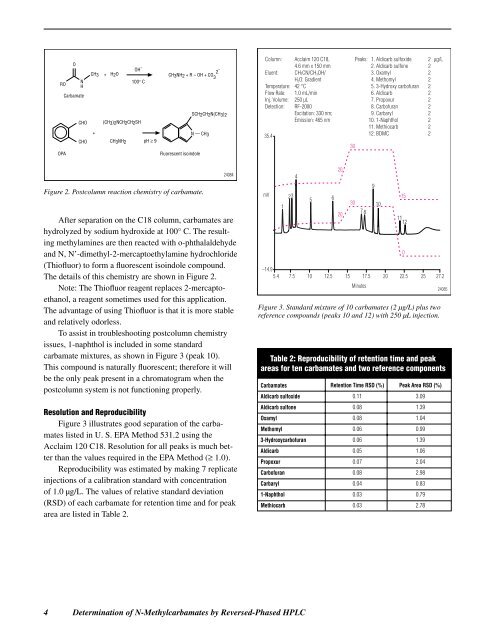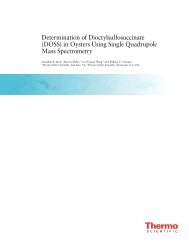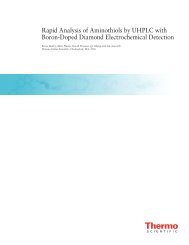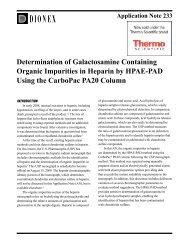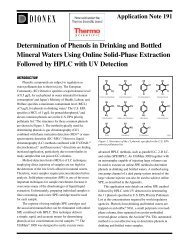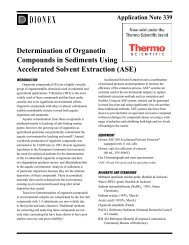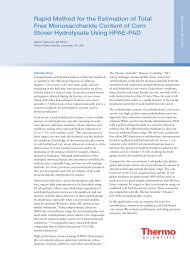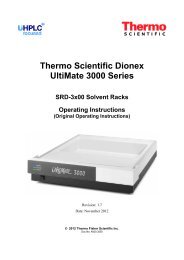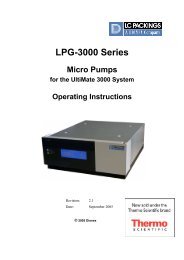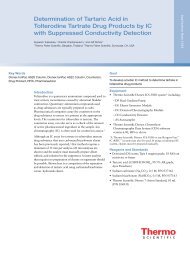AN96: Determination of N-Methylcarbamates by Reversed ... - Dionex
AN96: Determination of N-Methylcarbamates by Reversed ... - Dionex
AN96: Determination of N-Methylcarbamates by Reversed ... - Dionex
Create successful ePaper yourself
Turn your PDF publications into a flip-book with our unique Google optimized e-Paper software.
RO<br />
OPA<br />
O<br />
N<br />
H<br />
Carbamate<br />
CHO<br />
CHO<br />
CH 3<br />
+<br />
+<br />
H 2 O<br />
OH -<br />
100 ° C<br />
(CH 3 ) 2 NCH 2 CH 2 SH<br />
CH 3 NH 2<br />
pH ≥ 9<br />
2<br />
CH 3 NH 2 + R – OH + CO<br />
3<br />
-<br />
SCH 2 CH 2 N(CH 3 ) 2<br />
N — CH 3<br />
Fluorescent isoindole<br />
Figure 2. Postcolumn reaction chemistry <strong>of</strong> carbamate.<br />
After separation on the C18 column, carbamates are<br />
hydrolyzed <strong>by</strong> sodium hydroxide at 100° C. The resulting<br />
methylamines are then reacted with o-phthalaldehyde<br />
and N, N’-dimethyl-2-mercaptoethylamine hydrochloride<br />
(Thi<strong>of</strong>luor) to form a fluorescent isoindole compound.<br />
The details <strong>of</strong> this chemistry are shown in Figure 2.<br />
Note: The Thi<strong>of</strong>luor reagent replaces 2-mercaptoethanol,<br />
a reagent sometimes used for this application.<br />
The advantage <strong>of</strong> using Thi<strong>of</strong>luor is that it is more stable<br />
and relatively odorless.<br />
To assist in troubleshooting postcolumn chemistry<br />
issues, 1-naphthol is included in some standard<br />
carbamate mixtures, as shown in Figure 3 (peak 10).<br />
This compound is naturally fluorescent; therefore it will<br />
be the only peak present in a chromatogram when the<br />
postcolumn system is not functioning properly.<br />
Resolution and Reproducibility<br />
Figure 3 illustrates good separation <strong>of</strong> the carbamates<br />
listed in U. S. EPA Method 531.2 using the<br />
Acclaim 120 C18. Resolution for all peaks is much better<br />
than the values required in the EPA Method (≥ 1.0).<br />
Reproducibility was estimated <strong>by</strong> making 7 replicate<br />
injections <strong>of</strong> a calibration standard with concentration<br />
<strong>of</strong> 1.0 µg/L. The values <strong>of</strong> relative standard deviation<br />
(RSD) <strong>of</strong> each carbamate for retention time and for peak<br />
area are listed in Table 2.<br />
Column: Acclaim 120 C18,<br />
4.6 mm x 150 mm<br />
Eluent: CH3CN/CH3OH/<br />
H 2O: Gradient<br />
Temperature: 42 °C<br />
Flow Rate: 1.0 mL/min<br />
Inj. Volume: 250 µL<br />
Detection: RF-2000<br />
Excitation: 330 nm;<br />
Emission: 465 nm<br />
4 <strong>Determination</strong> <strong>of</strong> N-<strong>Methylcarbamates</strong> <strong>by</strong> <strong>Reversed</strong>-Phased HPLC<br />
24084<br />
35.4<br />
mV<br />
1<br />
23<br />
4<br />
–14.9<br />
5.4 7.5 10 12.5 15 17.5 20 22.5 25 27.2<br />
Table 2: Reproducibility <strong>of</strong> retention time and peak<br />
areas for ten carbamates and two reference components<br />
Carbamates<br />
Aldicarb sulfoxide<br />
Aldicarb sulfone<br />
Oxamyl<br />
Methomyl<br />
3-Hydroxycarb<strong>of</strong>uran<br />
Aldicarb<br />
Propoxur<br />
Carb<strong>of</strong>uran<br />
Carbaryl<br />
1-Naphthol<br />
Methiocarb<br />
5<br />
6<br />
20<br />
20<br />
30<br />
30<br />
Peaks: 1. Aldicarb sulfoxide 2 µg/L<br />
2. Aldicarb sulfone 2<br />
3. Oxamyl 2<br />
4. Methomyl 2<br />
5. 3-Hydroxy carb<strong>of</strong>uran 2<br />
6. Aldicarb 2<br />
7. Propoxur 2<br />
8. Carb<strong>of</strong>uran 2<br />
9. Carbaryl 2<br />
10. 1-Naphthol 2<br />
11. Methiocarb 2<br />
12. BDMC 2<br />
7 8<br />
Minutes<br />
9<br />
10<br />
Retention Time RSD (%) Peak Area RSD (%)<br />
0.11 3.09<br />
0.08 1.39<br />
0.08 1.04<br />
0.06 0.99<br />
0.06 1.39<br />
0.05 1.06<br />
0.07 2.04<br />
0.08 2.98<br />
0.04 0.83<br />
0.03 0.79<br />
0.03 2.78<br />
15<br />
11 12<br />
Figure 3. Standard mixture <strong>of</strong> 10 carbamates (2 µg/L) plus two<br />
reference compounds (peaks 10 and 12) with 250 µL injection.<br />
0<br />
24085


